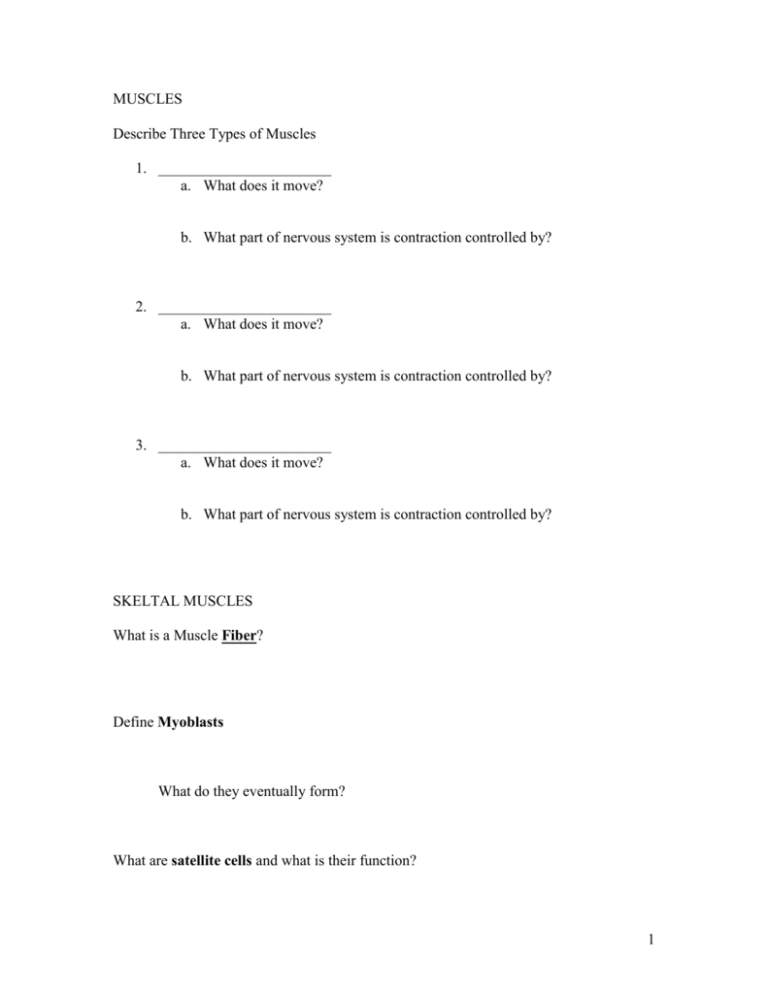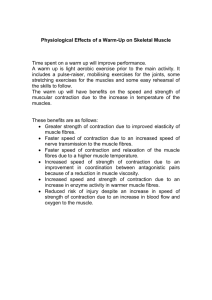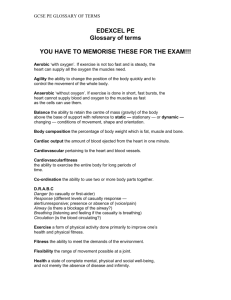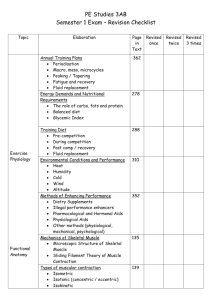File
advertisement

MUSCLES Describe Three Types of Muscles 1. _______________________ a. What does it move? b. What part of nervous system is contraction controlled by? 2. _______________________ a. What does it move? b. What part of nervous system is contraction controlled by? 3. _______________________ a. What does it move? b. What part of nervous system is contraction controlled by? SKELTAL MUSCLES What is a Muscle Fiber? Define Myoblasts What do they eventually form? What are satellite cells and what is their function? 1 Define the following layers of the muscle: Endomysium Perimysium What is a fascicle? Epimysium something to remember: all three of these layers are made of connective tissue which is continuous with the tendons which then connect to the bones Define: Origin of muscle: Insertion of muscle: Synergistic muscles: Antagonistic muscles: Tendon: 2 Morphology of Fibers As you know, muscle fibers are long, multinucleated cells, so naturally they contain all of the normal cell structures…they are just called slightly different names specific to muscles Define: 1. sarcoplasm: 2. sarcolemma: 3. sarcoplasmic reticulum: 4. transverse tubules: 5. myofibrils: Composed of: Microfilaments: two types: Thick filaments: Main protein: ___________ Thin filaments: Main protein: ___________ Sarcomere: What gives striated (striped) appearance? Explain what each structure of the Sarcomere is composed of and then draw a rough sketch and label the parts. 1. A Band: 3 a) H zone: b) M-line: 2. I Band: z-line: Show all of these structures below: helpful hint…if you know how to draw this picture yourself, you can draw it on the test and it can help you to answer questions Actin: Myosin: Each head contains: a) b) Four step cycle: How does a sarcomere shorten? The best thing to do in this situation is to draw your own picture very similar to the one in the text…you know…the one with the myosin head, actin filaments, and the atp…and just memorize how to draw it on your own. This way you know exactly what happens when ATP is bound or when it is not, etc. When you get to 4 the test you can draw it and it will be easier to answer the questions about it. Remember… nothing fancy…just something that can give you a visual of what is happening rather than just memorizing words! Draw your first one here and while you are studying do it a couple times without looking to get it into your mind: What is Rigor Mortis and what causes it? Role of Calcium Ions in Muscle Contraction Thin filament composed of 3 proteins a) Actin b) Tropomyosin: c) Troponin: What happens when Ca++ binds to troponin? Force proportional to number of cross bridges formed # of cross bridges proportional to # of binding sites available # of binding sites proportional to # of troponin molecules bound to calcium Therefore, force of contraction is proportional to [calcium ions] in cytosol this is an important concept Remember that the force of contraction is not at all related to the “strength” of the action potential (of course not because action potentials are all of the same magnitude) BUT: the more action potentials that fire (higher frequency) causes more calcium to be available for troponin binding, exposing more active sites for stronger contraction *in order to stop contraction, lower the Ca++ concentration and allow actin to be covered up by the tropomyosin Excitation-Contraction Coupling 5 Describe the sequence of events by which an action potential in sarcolemma leads to cross-bridge activity by increasing Ca++ concentration. Here are some key words you should use - Neuromuscular junction - End plate - Sarcoplsmic reticulum - Terminal cisternae - Transverse tubules (t-tubules) What causes a twitch? What causes prolonged muscle contraction? Mechanics of Single Fiber Contraction Define: Tension: Load: Opposing forces: Isometric (constant length): 6 Isotonic (constant tension): Lengthening contraction: What is the importance of Force summation in muscle contraction and what is it caused by? Define Tetanus: Unfused tetanus: Fused tetanus: Fused muscle tension: Tension on an external load is proportional to: 1. 2. Summation of Tension during a tetanic contraction is due to: 1. 7 Internal tension reached during single twitch is limited by: a) b) repeated stimulation maintains a high calcium concentration in the cytosol, and thereby increases the tension (summation) 2. Length-Tension Relationship What is the Optimal length? Energy Metabolism What is ATP? Why is it important for muscles to be able to manufacture a lot of ATP? What are three ways ATP is formed? 1. 2. 3. 8 Glycolysis: - Definition: - Where does it occur? - What is used up? - What is produced? Anaerobic Fermentation: - Definition: - Aerobic Respiration Pathways: - Advantage of this pathway? - Disadvantage? Where does it occur? - What is used up? - What is produced? - Advantage of this pathway? - Where does it occur? - Disadvantage? - What is used up? - What is produced? Krebs Cycle: - Definition: Electron Transport Chain: - Definition: - Where does it occur? - What is used up? - What is produced? 9 Write the overall equation for aerobic respiration: Pathway changes during exercise 1. Moderate exercise 2. Heavy exercise 3. After exercise oxygen consumption stays elevated because: Why is Muscle Fatigue Important? two reasons 1. failure of fiber to maintain tension as a result of prolonged activity How? 2. prevents ATP depletion How? What are the three types of skeletal muscle fibers? Define them and describe what kind of muscle activity each is used for: A. B. C. 10 Whole Muscle Contraction Control of Tension Muscle tension depends upon 1. a. b. c. d. 2. a. b. Define a Motor unit: How does the size of a motor unit influence control of muscle? Recruitment ordered: a. slow-oxidative motor units are first b. fast-oxidative motor units are next c. fast glycolytic motor units are last during moderate-strength contractions – endurance type exercise – during high intensity, short duration contractions such as weight lifting – 1. Direction of Change a. Atrophy: 1) denervation atrophy: 11 2) disuse atrophy: b. Hypertrophy: Memorize all the changes that can occur in muscles! Lever Action of Muscle and Bones Lever: Bones are levers in your body, joints are the fulcrums Load is the weight to be moved, effort is the force of the muscles Define and Draw pictures of these Determine if mechanical advantages or disadvantages 1. first class lever 2. second class lever 3. third class lever 12 Load x distance from load to fulcrum = effort x distance from muscle to fulcrum Mechanical advantage: Mechanical disadvantage: Smooth Muscles Stucture How is the structure of smooth muscle different than skeletal muscle? A. Shape and size? B. Not a synctium … which means: C. Organization of actin and myosin? D. Length-Tension relationship What is the Adaptive Value of Smooth muscle? Excitation – Contraction Coupling A. Regulated by [Calcium] in cytoplasm (like skeletal and cardiac muscles) 1. Calcium enters upon depolarization of plasma membrane What two places does it come from? Which one contributes more? 2. fiber small, so distance calcium most diffuse is short (skeletal fibers need large internal supply and internal conducting apparatus because they are so thick) 13 B. Calcium regulates enzymatic phosphorylation of myosin 1. calmodulin: 2. calcium – calmodulin complex: 3. activated kinase uses ATP to phosphorylate myosin C. Different myosin ATPase in smooth muscles Explain why: 1. velocity of shortening is low 2. economical means of maintaining tension 3. resistant to fatigue D. Relaxation Explain How: E. Regulation of tension How? Stimulation A. Spontaneous electrical activity How does this occur? B. Neurotransmitters and Hormones 1. receptors dispersed over muscle membrane (no end-plate region) 14 2. postganglionic fibers of autonomic nervous system enter muscle and divide into many branches, each containing a series of swollen regions called varicosities containing neurotransmitters 3. multiple innervations Both sympathetic and parasympathetic 4. multiple stimulation necessary for contraction a. depolarization from neurotransmitters released from one action potential is SUBTHRESHOLD at any spot b. multiple action potentials of nerve required to depolarize muscle to threshold by means of summation (like EPSP in CNS) 5. hormones can interact with receptors (and modify muscle activity) because of the “open” and diffuse nature of receptors Most important are those from the adrenal medulla a. b. C. Local Factors (how do these control contraction?) 1. Stretch 2. Chemical change in environment (in what ways and how do they control contraction?) Types of Muscles A. Single-Unit: 15 1. Gap Junctions: 2. Initiation of Contraction controlled by? a. b. c. d. 1) 2) B. Multi-Unit: Cardiac Muscle 1. innervated by: Excitatory Inhibitory 2. autostimulation how? 3. striated do they contract more like smooth or skeletal muscle? 16








